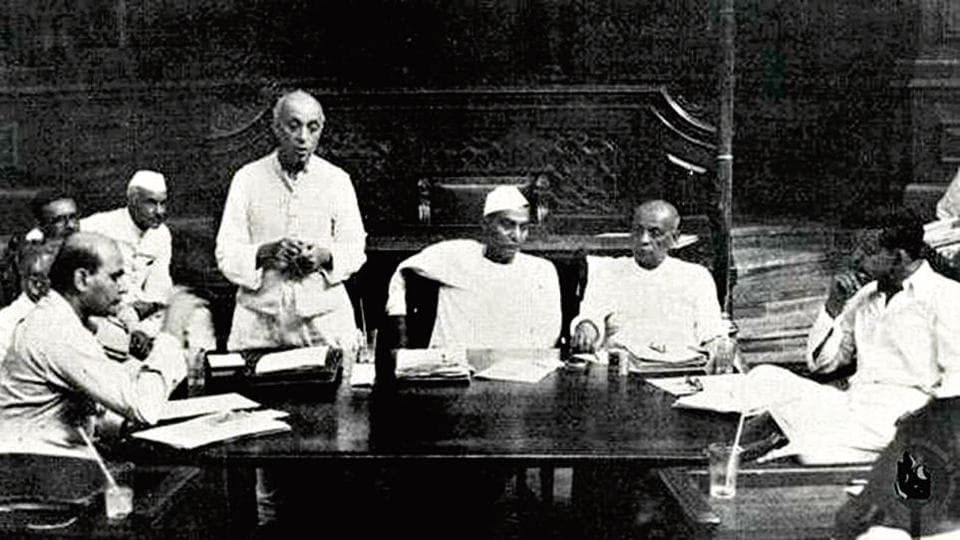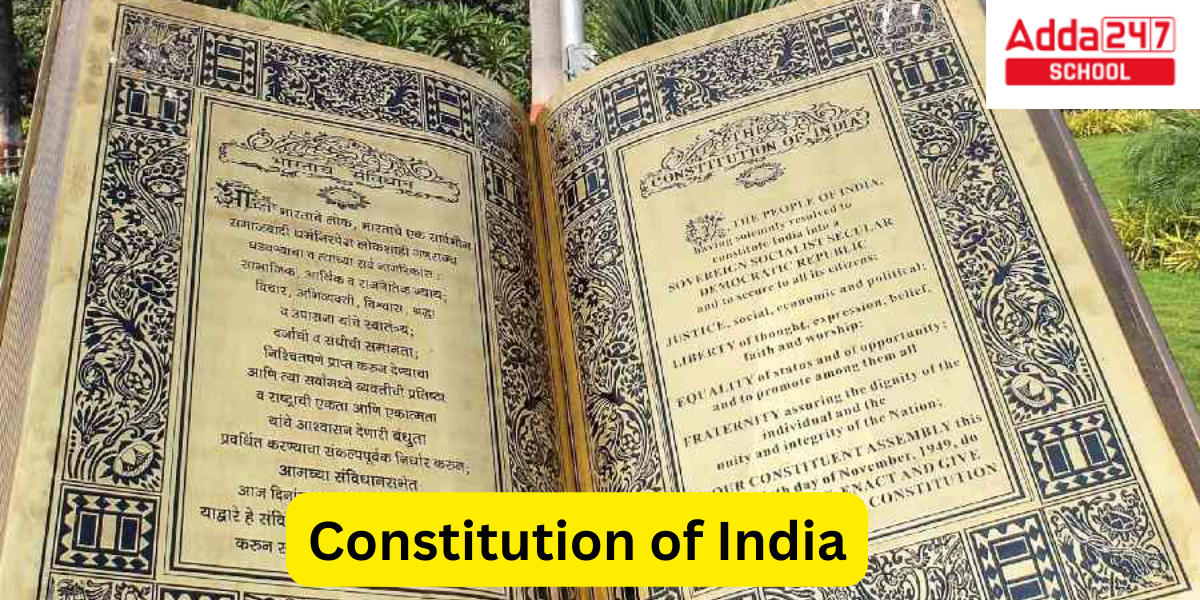Constitution of India
The Constitution of India is the country’s highest law. The Indian Constitution outlines the framework that delineates the core political code, as well as the fundamental rights, guiding principles, and responsibilities of citizens. It also spells out the organization, methods, powers, and duties of governmental institutions. It is the world’s longest-written national constitution.
It confers constitutional supremacy (as opposed to parliamentary supremacy, given that a constituent assembly rather than Parliament produced it), and its preamble contains a proclamation that it was ratified by the people. The constitution cannot be overruled by parliament.
Constitution of India Purpose
The Constitution of India Purpose makes India a great country. The Constitution of India serves several fundamental purposes. It was adopted on January 26, 1950, and it outlines the framework and principles that govern the country. The main purposes of the Indian Constitution are as follows:
- Establishing the framework of governance: The Constitution lays down the structure of the government, defines its various organs, and delineates their powers and functions. It establishes a federal system of government with a division of powers between the central government and the state governments.
- Sovereign, Socialist, Secular, and Democratic Republic: The Preamble of the Indian Constitution declares India to be a sovereign, socialist, secular, and democratic republic. These values are enshrined in the Constitution to ensure that India remains a nation that respects and upholds these principles.
- Protection of fundamental rights: The Constitution guarantees fundamental rights to all citizens of India, ensuring individual freedoms, equality, and justice. These rights are enforceable in a court of law and protect citizens from arbitrary actions of the government.
- Directive Principles of State Policy: The Constitution includes Directive Principles of State Policy, which are guidelines for the government to promote social justice, economic welfare, and the overall well-being of the people. While not legally enforceable, these principles serve as a moral imperative for the government to strive towards.
- Separation of powers: The Constitution establishes a system of checks and balances, separating the powers among the legislature, executive, and judiciary. This separation ensures that no single branch of government becomes too powerful and that each branch acts as a check on the others.
- Unity and Diversity: India is a diverse country with various linguistic, religious, and cultural groups. The Constitution aims to promote unity while respecting and protecting this diversity. It recognizes different languages and cultures and allows for cultural and educational autonomy.
- Constitutional Amendments: The Constitution provides a process for its own amendment to adapt to changing times and requirements. However, certain fundamental features of the Constitution, known as “basic structure,” cannot be altered.
- Rule of Law: The Constitution establishes the rule of law, ensuring that all individuals, including government officials, are subject to and must abide by the law. This principle ensures a just and fair society where no one is above the law.
- Independent Judiciary: The Constitution establishes an independent judiciary to safeguard the rights and liberties of citizens and to interpret and uphold the Constitution. The judiciary acts as a protector of the Constitution and ensures its supremacy.
- Pledge for citizens and public servants: The Constitution requires citizens and public servants to pledge allegiance to the nation and its principles, emphasizing the commitment to uphold the values and duties prescribed by the Constitution.
Overall, the Constitution of India serves as the guiding document for the governance of the country, ensuring that India remains a democratic and just nation, upholding the principles of equality, liberty, and social justice for all its citizens.
On 26 November 1949, the Indian Constituent Assembly approved it, and on 26 January 1950, it went into effect. The Dominion of India became the Republic of India when the constitution took the place of the Government of India Act 1935 as the primary law governing the nation. Article 395 of the constitution was repealed by its framers to secure constitutional autochthony. Republic Day, which is observed on January 26, honours India’s constitution.
India is proclaimed to be a sovereign, socialist, secular, and democratic republic in the constitution, which also guarantees its citizens justice, equality, and liberty while working to foster fraternity. At the Parliament House in New Delhi, the original 1950 constitution is kept in a nitrogen-filled case. The 42nd amendment act, passed in 1976 during the Emergency, added the phrases “secular” and “socialist” to the preamble.
Preamble of the Constitution of India
The preamble states that the constitution of India is a result of the solemn decision of the Indian people to establish a “Sovereign Socialist Secular Democratic Republic” and to achieve the clearly stated goals outlined in the preamble. The word “sovereignty” signifies absolute and supreme power. It might be actual or typical, governmental or political, personal or pluralistic. In monarchies, the monarchs themselves held the authority to rule. However, with republican forms of governance, which predominate largely in the modern world, sovereignty is transferred to the chosen officials of the populace.

Constitution of India: Background
- A committee known as the Nehru Report was established in Lucknow in 1928 by the All Parties Conference to draught the Indian Constitution.
- From 1857 to 1947, the majority of colonial India was governed by the British.
- Since each princely state was persuaded to sign the articles of integration with India by Sardar Patel and V.P. Menon, the same laws were in place from 1947 to 1950 while India was a British dominion, and the British government remained in charge of the nation’s foreign security.
- As a result, when the Indian Constitution took effect on January 26, 1950, it repealed both the Government of India Act 1935 and the Indian Independence Act 1947.
Constitution of India: Sources
The sources used to create the constitution were numerous. The Government of India Act of 1858, the Indian Councils Acts of 1861, 1892, and 1909, the Government of India Acts of 1919 and 1935, and the Indian Independence Act of 1947 were among the laws whose provisions were incorporated into this one while keeping in mind the needs and circumstances of India.
The former Constituent Assembly was split in half by the latter, which resulted in the establishment of India and Pakistan. Another crucial stage in creating the constitutions for two newly created countries is the Amendment Act of 1935. The ability to create and adopt a new constitution for the independent states resided solely with each new assembly.
Constitution of India: Timeline of formation
Here is the timeline of formation of the Constitution of India:
- Constitution Assembly formation took place on December 6, 1946. (in accordance with French practice).
- The inaugural gathering took place in the constitution hall on December 9th, 1946. (now the Central Hall of Parliament House).
- J. B. Kripalani, who replaced Sachchidananda Sinha as acting president, was the first to speak. (The Muslim League boycotted the meeting because it demanded a separate state.)
- On December 11th, 1946, the Assembly chose B. N. Rau to serve as its constitutional legal adviser, H. C. Mukherjee as vice-chairman, and Rajendra Prasad as president. (There were initially 389 members overall; following partition, there were 299 members. 292 of the 389 members were from government provinces, four were from chief commissioner provinces, and 93 were from princely states.)

- Jawaharlal Nehru gave a “Objective Resolution” on December 13th, 1946, outlining the foundational ideas of the constitution. Later, this was incorporated into the Constitution’s Preamble.
- 22 January 1947: Unanimous approval of the objective resolution.
- Adoption of the national flag on July 22.
Independence was won on August 15, 1947. Pakistan and India each have their own dominions within India. - On August 29, 1947, a committee was established, with B. R. Ambedkar serving as its chairman. Munshi, Muhammad Sadulla, Alladi Krishnaswamy Iyer, N. Gopalaswami Ayyangar, Khaitan, and Mitter made up the remaining six members of the committee.
- On July 16, 1948, V. T. Krishnamachari was chosen to serve as the second vice-president of the Constituent Assembly alongside Harendra Coomar Mookerjee.
- The assembly passed and ratified the Indian Constitution on November 26 1949.
- The Constituent Assembly’s final meeting was on January 24, 1950. The Constitution was ratified by signature (with 395 Articles, 8 Schedules, and 22 Parts).
- Taking effect on January 26, 1950, was the Constitution. (The procedure was completed in 2 years, 11 months, and 18 days for a total cost of 6.4 million.)
Constitution of India: Articles and Structure
The longest constitution for a sovereign state in the world is that of India. It contained 395 articles divided into 22 parts and 8 schedules when it was enacted. It is the second-longest active constitution in the world, after the Constitution of Alabama, with roughly 145,000 words.
The 470 articles that make up the constitution are divided into 25 parts and preceded by a prologue. It includes 12 schedules and 5 appendices, has undergone 105 amendments, the most recent of which took effect on August 15, 2021.
The constitution’s articles are grouped into the following parts:
| Parts of Constitution of India | ||
| Part | Name of the Part | Articles of the Part |
| Preamble with the words “socialist”, “secular” and ‘integrity’ that were added in 1976 by 42nd amendment of Constitution of India | ||
| Part I | The Union and its Territory | Articles 1 to 4 |
| Part II | Citizenship | Articles 5 to 11 |
| Part III | Fundamental Rights | Articles 12 to 35 |
| Part IV | Directive Principles of State Policy | Articles 36 to 51 |
| Part IV A | Fundamental Duties | Article 51A |
| Part V | The Union | Articles 52 to 151 |
| Part VI | The States | Articles 152 to 237 |
| Part VII | States in the B part of the first schedule (repealed) | Article 238 |
| Part VIII | Union Territories | Articles 239 to 242 |
| Part IX | Panchayats | Articles 243 to 243(O) |
| Part IX A | Municipalities | Articles 243(P) to 243(ZG) |
| Part IX B | Co-operative societies | Articles 243(ZH) to 243(ZT) |
| Part X | Scheduled and tribal areas | Articles 244 to 244A |
| Part XI | Relations between the Union and the States | Articles 245 to 263 |
| Part XII | Finance, property, contracts and suits | Articles 264 to 300A |
| Part XIII | Trade and commerce within India | Articles 301 to 307 |
| Part XIV | Services under the union and states | Articles 308 to 323 |
| Part XIV A | Tribunals | Articles 323A to 323B |
| Part XV | Elections | Articles 324 to 329A |
| Part XVI | Special provisions relating to certain classes | Articles 330 to 342 |
| Part XVII | Languages | Articles 343 to 351 |
| Part XVIII | Emergency provisions | Articles 352 to 360 |
| Part XIX | Miscellaneous | Articles 361 to 367 |
| Part XX | Amendment of the Constitution | Articles 368 |
| Part XXI | Temporary, transitional and special provisions | Articles 369 to 392 |
| Part XXII | Short title, date of commencement, authoritative text in Hindi and repeals | Articles 393 to 395 |
Constitution of India Purpose: Video for CUET PG Preparation
Below is the video of Constitution of India for CUET PG, DULLB 2023, CLAT 2024, AILET 2024, and other Exams:
Constitution of India purpose: Video for Law Preparation
Below is the Video of Constitution of India Part 1, for Preparation of Law Exams like DULLB 2023, AILET 2024, CLAT 2024, and MHCET Law:
Below is the Video of Constitution of India Part 2, for Preparation of Law Exams like DULLB 2023, AILET 2024, CLAT 2024, and MHCET Law:











 HPBOSE Compartment Date Sheet 2025 Out, ...
HPBOSE Compartment Date Sheet 2025 Out, ...
 RUHS Counselling 2025 Round 1 Seat Allot...
RUHS Counselling 2025 Round 1 Seat Allot...
 Bihar Board Dummy Registration Card 2026...
Bihar Board Dummy Registration Card 2026...










